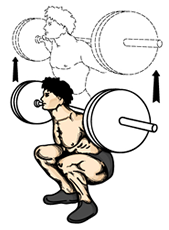Squat (exercise)
Squat (exercise)
The squat is a compound, full-body exercise that primarily trains the muscles of the thighs, hips and buttocks, quadriceps femoris muscle (vastus lateralis, vastus medialis, vastus intermedius, and rectus femoris), hamstrings, as well as strengthening the bones, ligaments, and insertion of the tendons throughout the lower body. Squats are considered a vital exercise for increasing the strength and size of the lower body muscles as well as developing core strength. The squat is one of the three lifts in the strength sport of powerlifting, alongside the deadlift and the bench press.
Execution[edit | edit source]
The basic movement involves lowering the body into a squatting position with the hips sinking back and down, and then returning to a standing position. Variations of the squat can be performed to target different muscle groups or to accommodate different levels of fitness. These include the back squat, where the weight is held across the upper back, and the front squat, where the weight is held in front of the body. Other variations include the overhead squat (weight held overhead), the goblet squat (weight held in front of the chest with both hands), and the split squat (a lunge-like movement).
Technique[edit | edit source]
Proper technique is critical to effectively performing a squat and avoiding injury. Key points include keeping the back straight, the chest up, and the knees tracking over the toes. The depth of the squat can vary, with a deeper squat generally increasing the engagement of the gluteal muscles. However, the depth should be adjusted according to the individual's flexibility, strength, and any existing knee or back issues.
Benefits[edit | edit source]
Squats are highly effective for building muscle, strengthening the core, and increasing flexibility. They also promote fat burning and can improve circulation, bone density, and posture. Regularly performing squats can also enhance athletic performance, making them a popular choice among athletes from various sports.
Safety Considerations[edit | edit source]
While squats are generally safe when performed correctly, improper technique can lead to injuries, particularly in the knees and lower back. It is recommended to learn the exercise under the guidance of a fitness professional and to use a weight that is manageable while maintaining proper form.
Variations[edit | edit source]
- Back Squat: The most common variation, involving a barbell placed on the trapezius muscle near the neck.
- Front Squat: Involves holding the barbell in front of the body, across the shoulders.
- Overhead Squat: Requires holding the weight overhead, demanding significant stability and flexibility.
- Goblet Squat: Performed with a dumbbell or kettlebell held at chest level.
- Split Squat: A single-leg squat variation that resembles a lunge.
See Also[edit | edit source]
This exercise related article is a stub. You can help WikiMD by expanding it.
Search WikiMD
Ad.Tired of being Overweight? Try W8MD's physician weight loss program.
Semaglutide (Ozempic / Wegovy and Tirzepatide (Mounjaro / Zepbound) available.
Advertise on WikiMD
|
WikiMD's Wellness Encyclopedia |
| Let Food Be Thy Medicine Medicine Thy Food - Hippocrates |
Translate this page: - East Asian
中文,
日本,
한국어,
South Asian
हिन्दी,
தமிழ்,
తెలుగు,
Urdu,
ಕನ್ನಡ,
Southeast Asian
Indonesian,
Vietnamese,
Thai,
မြန်မာဘာသာ,
বাংলা
European
español,
Deutsch,
français,
Greek,
português do Brasil,
polski,
română,
русский,
Nederlands,
norsk,
svenska,
suomi,
Italian
Middle Eastern & African
عربى,
Turkish,
Persian,
Hebrew,
Afrikaans,
isiZulu,
Kiswahili,
Other
Bulgarian,
Hungarian,
Czech,
Swedish,
മലയാളം,
मराठी,
ਪੰਜਾਬੀ,
ગુજરાતી,
Portuguese,
Ukrainian
Medical Disclaimer: WikiMD is not a substitute for professional medical advice. The information on WikiMD is provided as an information resource only, may be incorrect, outdated or misleading, and is not to be used or relied on for any diagnostic or treatment purposes. Please consult your health care provider before making any healthcare decisions or for guidance about a specific medical condition. WikiMD expressly disclaims responsibility, and shall have no liability, for any damages, loss, injury, or liability whatsoever suffered as a result of your reliance on the information contained in this site. By visiting this site you agree to the foregoing terms and conditions, which may from time to time be changed or supplemented by WikiMD. If you do not agree to the foregoing terms and conditions, you should not enter or use this site. See full disclaimer.
Credits:Most images are courtesy of Wikimedia commons, and templates, categories Wikipedia, licensed under CC BY SA or similar.
Contributors: Prab R. Tumpati, MD




